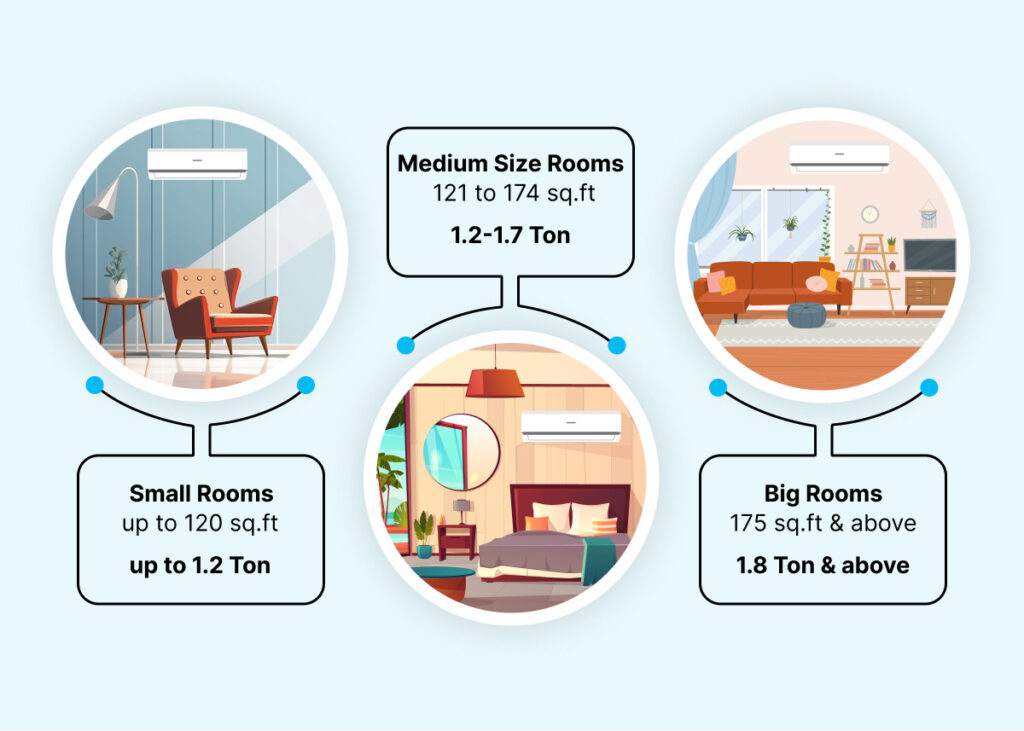If energy efficiency and environmental sustainability are important to you, selecting an air conditioner (AC) that consumes minimal power becomes a top priority. With a plethora of options available in the market, making an informed decision can be challenging. This guide aims to simplify the process, highlighting the key factors to consider when choosing an AC that not only provides optimal cooling but also keeps electricity bills in check. Whether you’re upgrading your current system or installing a new one, understanding the intricacies of energy-efficient air conditioning can lead to significant long-term savings and a smaller carbon footprint.
Understand What is A Suitable Size of AC for Your Home

Tips to Select the Best AC with Low Power Consumption
Before you get swayed by deals, discounts, or whopping offers, think about a few things. Examine the tips provided to find the best AC with low power consumption or the best AC that meets your requirements.
- Check the Energy Efficiency Ratio (EER)
What to Look For: ACs with a higher Energy Efficiency Ratio (EER), can be found on AC’s label
Why? The EER shows how efficiently the AC uses electricity to cool a room. A higher EER means better energy efficiency, which means lower power consumption and reduced electricity bills.
- Opt for Inverter Technology
What to Look For: AC must have inverter technology.
Why? Unlike traditional ACs that operate on a fixed speed, inverter ACs adjust the compressor speed based on the cooling demand. This eventually results in reduced energy consumption, consistent cooling, and reduced wear & tear.
- Look for Energy Star Ratings
What to Look For: Buy ACs with higher star ratings, indicated by a 3-star, 4-star, or 5-star label.
Why? The star rating system, regulated by the Bureau of Energy Efficiency (BEE) in India, indicates the energy efficiency of appliances. A higher star rating means less electricity consumption.
- Consider the Type of AC
What to Look For: Decide between split ACs and window ACs
Why? Split ACs are generally more energy-efficient than window ACs due to their design and advanced features. Split ACs are better performers when it comes to cooling larger spaces.
- Evaluate the Cooling Capacity
What to Look For: Choose the right tonnage for your room size. Usually ACs come in 1 ton, 1.5 ton, and 2 ton.
Why? Choosing an AC with the appropriate cooling capacity ensures efficient cooling without overworking the unit. A smaller AC will struggle to cool the space, leading to higher bills.
- Use Smart Controls
What to Look For: ACs with Wi-Fi connectivity and smart controls.
Why? Smart ACs can be controlled remotely via mobile apps, allowing you to monitor and adjust settings for optimal energy use, even when you’re not home. You can set schedules, change temperatures, and receive maintenance alerts, all contributing to energy savings.
- Read Reviews and Seek Recommendations
What to Look For: User reviews, expert recommendations, and ratings.
Why? Real-world feedback can provide insights into the actual performance, reliability, and energy efficiency of different AC models. Reviews can highlight any common issues or benefits experienced by other users, helping you make a more informed decision.
By carefully considering these tips, you can select an AC that not only keeps you cool but also minimizes your energy consumption, leading to cost savings and a reduced environmental impact. Investing in an energy-efficient AC is a smart choice for both your wallet and the planet.
Disclaimer: The purpose of this blog is to simplify complex processes for readers’ understanding. Please note that some information and screenshots provided may become outdated or change over time. However, we strive to keep our blogs updated and relevant to provide accurate and helpful information.
What are the key factors to consider when selecting an AC with low power consumption?
How do I determine the right cooling capacity for my space?
What are the benefits of inverter ACs?
Can I use a split AC in a small room?
How do I pay for my AC purchase using Paytm?
- 1. Go to the Paytm mobile app. 2. Scan either the shop’s QR code or their mobile number, enter the payment amount. 3. Choose the payment method (e.g., credit card, debit card, or UPI) and confirm the transaction.



